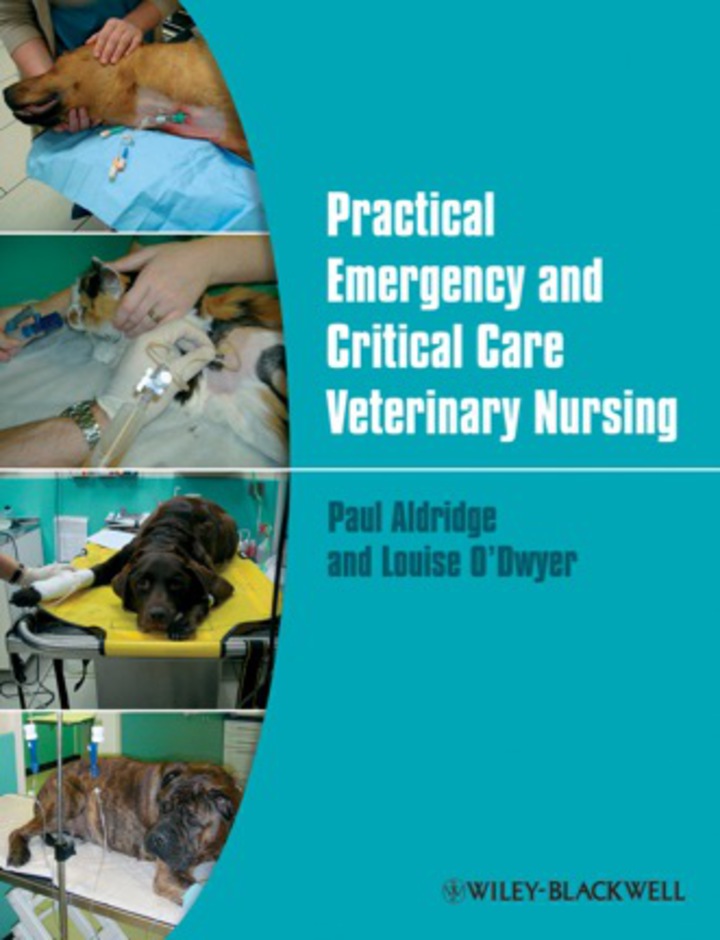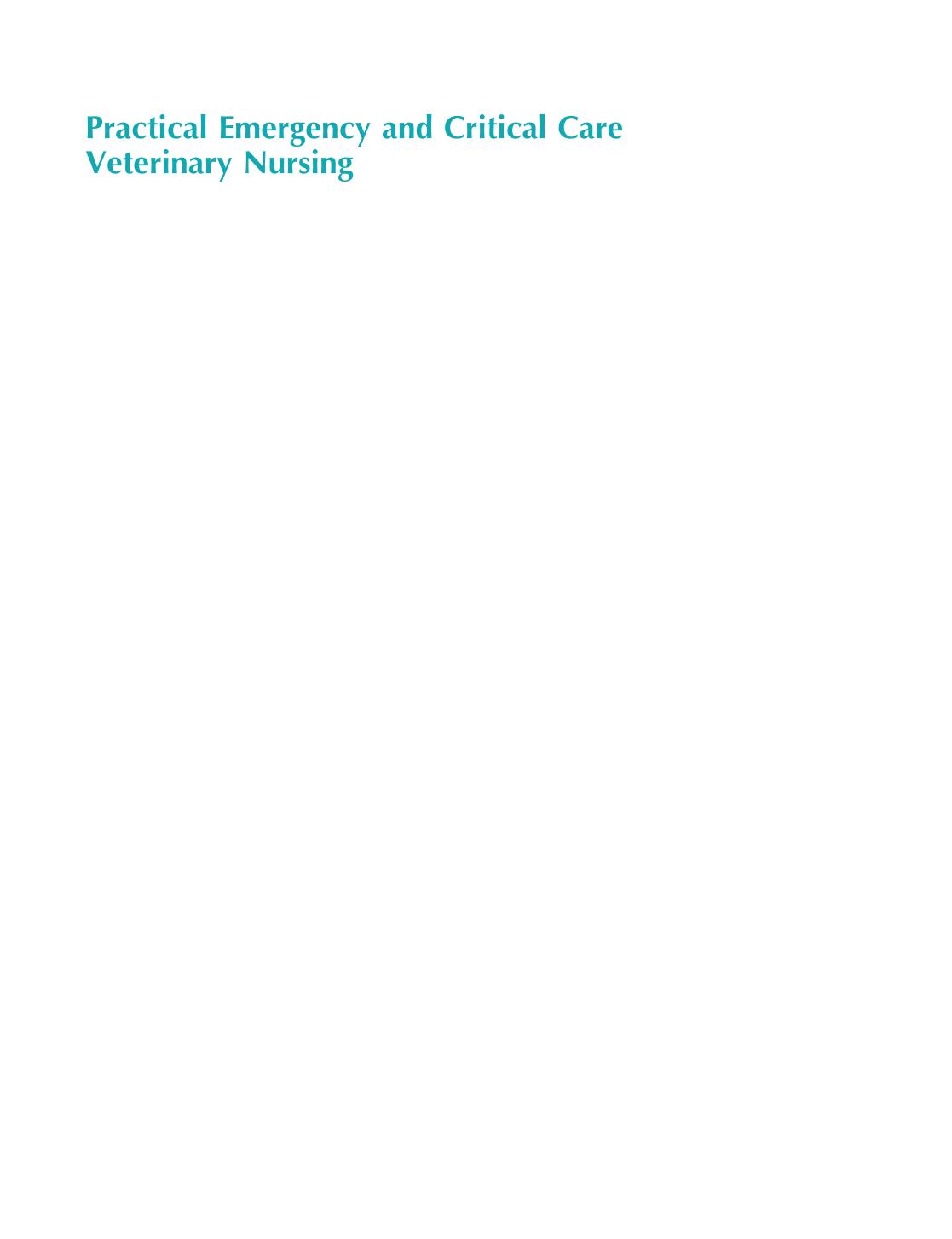Practical Emergency and Critical Care Veterinary Nursing 1st edition by Paul Aldridge, Louise O’Dwyer ISBN 1118483472 9781118483473
$70.00 Original price was: $70.00.$35.00Current price is: $35.00.
Instant download Practical Emergency and Critical Care Veterinary Nursing 1th Paul Aldridge after payment
Practical Emergency and Critical Care Veterinary Nursing 1st edition by Paul Aldridge, Louise O’Dwyer – Ebook PDF Instant Download/Delivery: 1118483472, 9781118483473
Full download Practical Emergency and Critical Care Veterinary Nursing 1st edition after payment

Product details:
ISBN 10: 1118483472
ISBN 13: 9781118483473
Author: Paul Aldridge, Louise O’Dwyer
Your step-by-step guide to key emergency and critical care procedures and hands-on nursing care. Whether you need to know how to prioritise your response to a patient with multiple injuries, or you need a quick practical guide to fluid therapy, this is the go-to resource. Colour photographs of real life cases take you through the procedures and after-care, detailing essential skills. This book provides vital information for emergency and critical care situations, whether you’re looking for confidence in handling emergency cases in a first-opinion practice, or a relevant, succinct guide for an emergency clinic. Be inspired to become more confident in your clinical skills and abilities, and learn how to apply your existing skills to an emergency situation.
A companion website provides additional resources useful in the management of emergency and critical patients. Visit the website to find information charts and video clips of procedures.
Written by a veterinary nurse and a veterinary surgeon who work together in the largest UK emergency clinic, this book is a practical, how-to manual with a nursing focus.
Suitable as a complete reference for nurses studying towards qualifications, or as a practical guide for daily use by veterinary nurses working in veterinary emergency and critical care.
Practical Emergency and Critical Care Veterinary Nursing 1st Table of contents:
-
Triage and Assessment of the Emergency Patient
-
Introduction
-
Telephone triage
-
Hospital triage
-
A and B: Respiratory system
-
C: Cardiovascular
-
D: Dysfunction of the central nervous system
-
Summary of triage
-
Secondary evaluation
-
-
Monitoring the Critical Patient
-
Introduction
-
Organ function
-
Respiratory system
-
Cardiovascular system
-
Central nervous system
-
Urinary system
-
Gastrointestinal system
-
Fluid balance
-
Body temperature
-
Clinical pathology
-
Blood glucose
-
Packed cell volume and total protein
-
Electrolytes
-
-
Pain scoring
-
Pain
-
Recumbency care
-
Practical techniques
-
Central venous pressure (CVP) measurement
-
Technique
-
Measurement of CVP using a manometer
-
-
-
Vascular Access
-
Introduction
-
Planning intravenous access
-
Catheter selection
-
Vein selection
-
Techniques for difficult cases
-
Improving access to veins
-
Intraosseous needles and catheters
-
Practical techniques
-
Placing an intravenous over-the-needle catheter
-
Placing a central catheter using the Seldinger technique
-
Placing an intraosseous needle in the femur
-
Placement of an arterial catheter
-
Catheterisation of the dorsal metatarsal artery
-
-
-
‘Shock’ and Intravenous Fluid Therapy
-
Normal physiology
-
Abnormal losses from fluid compartments
-
Forming a fluid therapy plan
-
Does the patient need fluid therapy?
-
Which route should be used?
-
Which fluid should be administered?
-
Rate, quantity, and duration of fluid therapy
-
Treatment of hypovolaemic shock and acute fluid therapy
-
Chronic fluid therapy: patients with normal perfusion parameters
-
Other methods for calculating fluid requirements
-
Duration of fluid therapy
-
Monitoring fluid therapy
-
Fluid balance measurement
-
-
Blood Gas, Acid–Base Analysis and Electrolyte Abnormalities
-
Introduction
-
Blood gas analysis
-
Assessing ventilation
-
Assessing acid–base status
-
Metabolic assessment
-
-
Treating acid–base disorders
-
Metabolic acidosis
-
Respiratory acidosis (hypoventilation)
-
Metabolic alkalosis
-
Respiratory alkalosis (hyperventilation)
-
-
Understanding electrolyte balance
-
Sodium (Hyponatraemia, Hypernatraemia)
-
Chloride (Hypochloraemia, Hyperchloraemia)
-
Potassium (Hypokalaemia, Hyperkalaemia)
-
Magnesium (Hypomagnesaemia, Hypermagnesaemia)
-
Calcium (Hypercalcaemia, Hypocalcaemia)
-
-
Further reading
-
-
Analgesia and Anaesthesia of the Emergency and Critical Patient
-
Introduction
-
Patient assessment
-
Respiration, Cardiovascular system, Neurological system
-
Anticipated problems and contingency plans
-
Anaesthesia drug plan
-
Sedatives, Analgesia, Neuroleptanalgesia
-
Opioids (Mu-agonist opioids, Morphine, Methadone, Pethidine, Fentanyl)
-
Opioid agonists/antagonists and partial agonists (Butorphanol, Buprenorphine, Tramadol)
-
Dissociative drugs
-
Local anaesthetics
-
-
General anaesthesia
-
Patient monitoring
-
Drug selection (Premedication, Induction drugs, Anaesthesia maintenance)
-
Peri-operative support
-
Postoperative considerations
-
-
Further reading
-
-
Practical Laboratory Techniques
-
Introduction
-
Laboratory tests
-
Electrolyte levels, Acid–base assessment
-
Haematology, Other tests
-
Packed cell volume and total protein, Saline agglutination
-
-
Prepare and examine blood films
-
Stains and film examination
-
Examination of red blood cells, Leucocytes, Platelets
-
Cytology of effusions, Fluid analysis
-
-
Glucose monitoring, Lactate measurement
-
Urinalysis
-
Specific gravity, Ketones, Urine sediment
-
Urine protein : creatinine ratio
-
-
Further reading
-
-
Techniques for Oxygen Supplementation
-
Introduction
-
Oxygen supplementation techniques
-
Short-term and longer-term methods
-
-
Endotracheal intubation
-
Oxygen toxicity
-
Practical techniques
-
Transtracheal catheterisation
-
Technique for nasal catheter placement
-
Endotracheal intubation
-
-
-
Nursing the Dyspnoeic Patient
-
Introduction
-
Initial presentation, Observation, Physical examination
-
Thoracic radiography
-
Practical techniques
-
Tracheostomy tube placement and care
-
-
-
Nursing the Cardiac Patient
-
Introduction
-
History, Clinical signs
-
Initial stabilisation of the cardiac patient
-
Assessment (Arterial blood pressure, Blood gases, Radiography, ECG, Echocardiography)
-
Common emergency presentations (Congestive heart failure, Arrhythmias, Thromboembolism)
-
Electrocardiography
-
Further reading
-
Nursing the Acute Abdomen Patient
-
Introduction
-
Presentation, History, Clinical examination
-
Stabilisation and Diagnostic techniques
-
Clinical pathology, Radiography, Ultrasound, Abdominocentesis
-
-
Surgical considerations and postoperative management
-
Common presentations (Gastric dilation, Haemoabdomen)
-
Practical techniques (FAST, Abdominocentesis, Diagnostic peritoneal lavage, Orogastric intubation)
-
Nursing Urinary Tract Emergencies
-
Introduction
-
Stabilisation of urinary tract obstruction and trauma
-
Urine diversion and collection systems
-
Monitoring urine output and complications of catheterisation
-
Practical techniques (Catheterising male/female cats and dogs, Peritoneal dialysis)
-
Nursing the Poisoned Patient
-
Introduction
-
Treatment and supportive care
-
Reducing absorption, Antidotes, Increasing elimination
-
Common toxicities (Metaldehyde, Anticoagulant rodenticides, Ethylene glycol, etc.)
-
Practical techniques (Gastric lavage)
-
Nursing the Trauma Patient
-
Introduction
-
Abdominal and Thoracic trauma management
-
Initial management, Stabilisation, Surgical exploration
-
Monitoring and treatment of head trauma
-
Wounds and fractures
-
Further reading
-
Nursing the Reproductive Patient
-
Introduction
-
Female reproductive disorders (Dystocia, Pyometra, Mastitis, etc.)
-
Male reproductive disorders (Penile, Testicular, Prostatic disorders)
-
Further reading
-
Small Animal Critical Care and Hospitalised Patient Nutrition
-
Introduction
-
Patient selection and nutritional needs
-
Re-feeding syndrome prevention
-
Feeding methods, Feeding tube choices
-
Complications and further reading
-
Nursing the Emergency Ophthalmology Patient
-
Introduction
-
Ocular trauma, Prolapsed globe, Hemorrhage, Foreign bodies
-
Diagnosis and treatment (Corneal laceration, Ulcers, Anterior uveitis, Glaucoma, Lens luxation)
-
Practical procedures (Pupillary light reflex, Schirmer tear test, Fluorescein)
-
Surgical procedures
-
Cardiopulmonary Arrest and Resuscitation
-
Introduction
-
Immediate recognition and early intervention
-
Resuscitation team and CPR
-
Monitoring during basic life support (BLS) and advanced life support (ALS)
-
Post-cardiac arrest care
-
Drugs in CPR
-
Further reading
-
Nursing Considerations in the Critical Patient
-
Introduction
-
Nursing considerations and planning
-
Fluid balance, Nutritional status, Care of catheters/tubes
-
Infection control, Pain management
-
-
Nursing the neurological patient
-
Mental well-being and client communication
-
Record keeping, Physiotherapy
-
Further reading
Index
People also search for Practical Emergency and Critical Care Veterinary Nursing 1st :
practical emergency resuscitation and critical care
practical emergency resuscitation and critical care pdf
practical emergency resuscitation and critical care 2nd edition pdf
manual of practical examination in critical care and emergency medicine
practical emergency resuscitation and critical care pdf download
Tags: Paul Aldridge, Louise O’Dwyer, Practical Emergency, Critical Care



